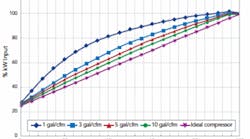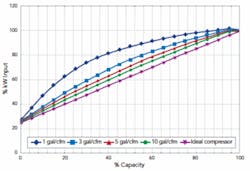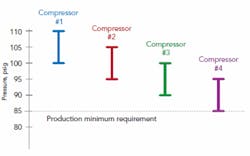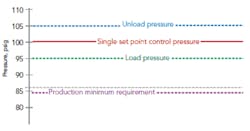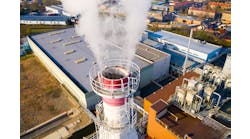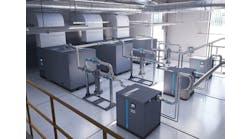Most people aren’t aware that compressed air is one of the most costly utilities in a plant. Typical wire-to-work efficiency of a 100-psi system is only about 10%–15% at best. That is, if you put 10 hp into an air compressor, you only can get about 1 hp of work out of the other end when operating a compressed-air-powered device or tool.
Worse yet, this efficiency ratio is for a perfect system — for the compressor running at 100 psi and at full load, its most efficient operating point. However, many compressors don’t operate in this way. Also, the ratio doesn’t include leakage or waste in a system and doesn’t consider pressure differentials across system components. This ratio is kind of like the gas mileage number that appears on the sticker of a new car, a value only attainable in the laboratory — not in real life.
[callToAction ]
There isn’t a lot you can do about most of this loss — it’s simple physics: when you compress air, the biggest product of the operation is heat. If you can use this heat, don’t let it go to waste. Heat recovery is the most effective way of making a compressed air system more efficient. (For more on the topic, see “Recover Heat from Air Compression.")
What’s left for your attention is to ensure your system is as close to perfect as possible.
Figure 1. Using larger storage makes lubricated screw compressors run more efficiently in load/unload mode.
Pervasive Problems
So, let’s look at 10 issues, mostly related to screw compressors, that frequently reduce the efficiency of compressed air systems.
Inefficient control mode. This is one of the most common efficiency problems. Compressors must be controlled to maintain constant system pressure. If uncontrolled compressors put too much air into the system, the pressure goes too high; if they put in less than you use, the pressure goes too low. The onboard compressor controller in each unit is tasked to ensure that just enough compressed air is added to your system to maintain a more-or-less constant pressure between set limits.
When matching the compressor capacity to the load, normally at least one compressor is operating at partial load, that is, not putting out its full capacity. And this is where using an efficient compressor control mode is important. Common control modes in order of most efficient to least efficient are:
• Variable speed — An inverter drive or special motor changes the speed of the compressor. The power in this mode decreases in almost direct proportion to the flow.
• Variable displacement — Bypassing through controlled ports reduces the effective length of the compression element. Useful for the top 50% of flow, power turns down about 7% for each 10% reduction in flow.
• Load/unload — The compressor alternately produces full or zero flow between two pressure set points. The average power decreases about 5%–6% per 10% drop in flow but only if the system has large storage receiver capacity.
• Modulation — The inlet of the compressor is choked off to control the output flow. The power turns down about 3% for every 10% reduction. Thus, if a compressor with this type of control is putting out 40% of its capacity, it’s consuming about 85% of full-load power.
What mode are your compressors operating in? Ask your service provider or someone in your plant who knows compressors. If your compressors are in modulation, you likely have some work to do to improve your efficiency. However, there usually are lots of potential opportunities to get compressors operating better with other modes of operation. Often in a system of multiple compressors, one or more may need replacement due to age. For a new unit, consider a more efficient mode.
Lack of storage. Too often a system doesn’t include enough storage receiver capacity. The presence of one or more large storage receivers near the compressor room helps the compressors maintain stable system pressure and run more efficiently. Receivers store a significant quantity of air that can prevent the system pressure from falling or rising too fast. This simplifies compressor control and could very well allow one or more compressors to turn off when not required instead of running unloaded, wasting power.
If a compressor is running in load/unload mode, the presence of large storage will make the compressor more efficient by reducing the frequency of load cycles. Figure 1 shows the effect of adding storage to lubricated screw compressors. As more storage is available, the power consumption at part loads decreases.
How large is “large?” Try to install 5–10 gal of capacity for each cfm of trim compressor capacity. (A trim compressor is one that operates at part load.) So, for a 100-hp compressor, put in between 2,000 and 4,000 gal. Yes, that’s a large tank but it usually will pay for itself many times over.
Pressure too high. Very often some well-meaning person in operations will set the compressor discharge pressure higher than is required by the users. Perhaps someone is occasionally experiencing low pressure. Or perhaps the compressors simply are rated at a high pressure, so the operator thinks why not set the pressure to the highest possible value?
Always keep in mind that operating at a high pressure costs roughly 5% more energy for every 10-psi increase in compressor discharge pressure. What’s more, if any compressed air use is unregulated, the flow of air consumed by the equipment will rise by almost 1% for every 1 psi in higher pressure. This loads the compressors more, making them consume even more power. Carefully researching your end-user requirements and reducing the pressure may allow you to decrease your compressor power and save operating costs.
High pressure drop. Systems often contain less-than-optimal components like piping, filters, air dryers, regulators, lubricators, connectors and hoses that cause excessive pressure drop. This may stem from the desire to save money on the component purchase. Smaller components are cheaper — but sometimes they create major pressure restrictions. For example, undersized components may cause a 25-psi pressure differential between the compressors and an air-operated cylinder that needs 90 psi to function properly. This would force the compressor discharge pressure to at least 90 + 25 = 115 psi. The higher the discharge pressure, the more power the compressor consumes. Proper component selection can solve this problem and might lower the pressure drop to 5–10 psi or less.
Poor compressor coordination. In systems with multiple compressors, it’s common to find that no defined control strategy is being employed to keep the compressors playing together properly. Perhaps pressure settings were selected to be all the same for each compressor. Or perhaps the settings are the default set by the factory. The result might be that the compressors are all fighting with each other, causing very inefficient operation and poor pressure control. Very often you can improve system efficiency by examining the compressor pressure set points and ensuring they are set correctly.
The most common way to set load/unload compressors is in a cascaded arrangement (Figure 2). This operation is typical in systems with four or fewer compressors. For systems with more than four, the best way to run the compressors is with a single pressure band, coordinated with some sort of compressor control algorithm (Figure 3). Sometimes the onboard compressor controls have this type of control built in. Other times an external controller is required. The effect of these control strategies is to reduce the number of running compressors and decrease the average system pressure, saving power.
High levels of waste. The reality is that compressed air systems often are ignored until pressure problems occur. If you don’t maintain your system, the normal wear and tear of plant operations will cause more and more compressed air leakage as time goes on. Typical plant leakage levels range between 20% and 30% of the average output. Really bad systems may exhibit levels of 50% or higher.
Figure 2. Coordinating compressor pressure bands in a cascaded arrangement makes the system operate more efficiently.
Do you have high levels of waste? Walk around your plant during non-production hours and listen. If your plant sounds like a pit of angry vipers, it may be time to do some leakage detection and repair.
Too many operating hours. Some plants run their compressors on evenings and weekends even when there’s no production. For a plant that operates only two shifts and not on weekends, the non-production hours actually can exceed the production ones. During this time, the load often is very light and due only to leakage. This leakage costs energy; address the loss by simply turning off your compressors during these periods. Reducing the compressors’ runtime also cuts required maintenance costs.
Sometimes critical loads such as boilers or fire systems need a small amount of compressed air during off hours, necessitating running the main compressors. In these cases, buy a small compressor to handle these loads, letting your main compressors rest.
No system monitoring. Many times there’s no way to tell if your system is operating efficiently or not. There are pressure gauges galore and often many temperature readouts but instruments to measure flow and power rarely are present on an average system. In the past, these extra meters were expensive but now their cost has come way down. Time and time again experience has shown that monitoring your system efficiency enables achieving significant power savings. You can’t manage what you don’t measure.
Sometimes system monitoring will come built into a compressor controller. If it does, then installing good control also can open your eyes to the efficiency of your system.
Inefficient air drying. The air compressors consume most of the energy in a typical compressed-air system but you shouldn’t ignore your air dryer efficiency. There are many efficiency choices when it comes to purchasing new units or upgrading your old ones.
For refrigerated dryers, energy often is wasted in running lightly loaded or with no load at all. Standard non-cycling dryers consume a constant power level even when little or no air is flowing through them. Choosing cycling dryers can reduce average power consumption. These units work like your refrigerator at home, turning the cooling circuit off and on with cooling demand.
Desiccant dryers, if uncontrolled, very often are found to be consuming the largest amount of compressed air in a plant. Heatless desiccant dryers require a flow of compressed air to regenerate the desiccant. This flow can be considerable if the dryer is oversized, lightly loaded and doesn’t have dew point control.
Selecting more efficient desiccant dryers with controls that turn off the purge flow when not required, or heated styles that use less (or no) compressed air flow for regeneration can save significant operating costs and free up some extra peak compressor capacity.
Figure 3. Use of a compressor controller best coordinates multiple compressors in a single pressure band.
Lack of information. A great many compressed air problems are caused because the operators of the equipment simply do not know any better. The solution to this problem is awareness training.
Inflate Efficiency
Your plant’s compressed air system likely suffers from at least some of the issues we’ve covered. Addressing them can lead to improved efficiency.
Attend A Compressed Air Seminar
Gain more insights about energy efficiency measures by attending compressed air training. Check out the Compressed Air Challenge training schedule at www.compressedairchallenge.org.
RON MARSHALL is principal of Marshall Compressed Air Consulting, Winnipeg, MB, and a Compressed Air Challenge instructor. E-mail him at [email protected].
